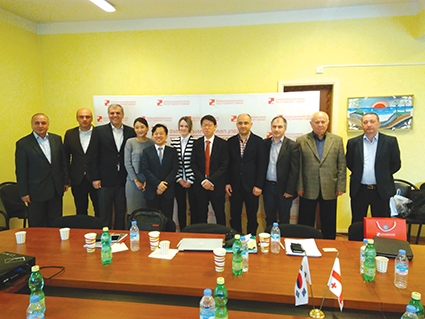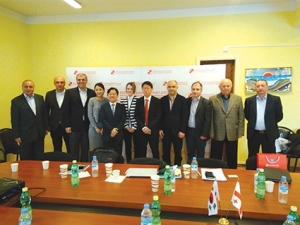Sustainable Urban Transportation in Tbilisi and Lessons from Seoul
Tbilisi traffic has become a point of consternation for the city’s residents, especially as population and income grows, adding to the number of cars on the road. Recently, the South Korean embassy has been taking proactive steps to offer support and expertise. On Friday, the South Korean embassy organized a seminar between leadership of the Tbilisi Transport Company (TTC) and the Korean Transportation Institute (KOTI). According to Kim In Hwan, Charge D’Affairs of the South Korean Embassy, his government is ready and willing to assist and finance traffic reforms and infrastructure in Tbilisi.
GEORGIA TODAY’s Charles Johnson sat down with Mr. Jin-Young Park, KOTI Director, on the sidelines of the conference to get his impressions on Tbilisi’s transportation system and what the city and government can do to improve the lives of its residents.
Can you briefly tell us about KOTI and the kind of work you do in Seoul?
KOTI is a research institute in Seoul that covers research and implementation of transportation initiatives in the country. We often act as an intermediary between operators, citizens, and government. My specialty is in urban transportation and sustainable development
What sparked your interest in Tbilisi’s transportation system and your current trip to Georgia?
The South Korean Embassy has been interested in this matter for a long time, and my colleagues in the industry told me that Georgia has great potential to be a lovely and livable city. After this I researched and read many reports about the situation here. It’s been very interesting to be here and to share the Korean experience with the Georgian people. I found quite similar pictures and figures between our two countries. If Tbilisi could learn from Seoul, it could end up a well-developed and better city.
What lessons from Seoul do you think are most relevant here?
Seoul has a long history and heritage, like Tbilisi. This means that the town was not planned for a large population with lots of traffic, much like here. Seoul also had a very similar experience of a rapid increase in population and cars on the road in the last forty years. In the Korean case, we were not totally successful in dealing with these problems, so we hope to share the experience in the hopes that Tbilisi can avoid some of these mistakes and improve their system.
Have you been able to tour the city during your time here? What were your impressions of our urban transportation system?
Frankly speaking – and this comes from my experience in having visited many cities like Delhi, Bangkok, Ho Chin Min City, and other places – conditions in Tbilisi are not so severe. That said, considering the previous conditions, Tbilisi is undoubtedly getting worse. But Tbilisi is still in a position to fix things.
Transportation overhauls take a lot of time and money. What short-term and long-term solutions exist for the government of Georgia?
Transportation should grow with the city. New metro extensions, for example, should be planned where you’re building large residential complexes in order to reduce the number of cars on the road. This is not a very easy solution because of car culture. In Asia, having a car improves your social position, much like here. However, the key is to keep these cars out of the center of the city by offering better commuting alternatives. From what I saw yesterday, I think much progress can be made by focusing on improving just a few choke points around the city. You see problems at just a few intersections that are rippling out to bad traffic across the city. You need bus lanes, public parking, and better traffic management. There are technical options to reduce traffic. Drawing a clear lane map is an example of a quick solution. Also, Tbilisi and Seoul have a similar problem with illegal parking. You cannot control every road, but you definitely have to control this on the major roads that are important for capacity.
How do you increase capacity and efficiency while also providing a safe environment for both drivers and pedestrians?
I’d have to spend more time getting to know the culture here better, but I noticed that speeds on the road are unusually high. Even coming from a place like Seoul where we are famous for our ‘hurry-hurry’ culture, I’d say that speeds are high here. Even now Korea is fighting to reduce accident rates and improve safety. It isn’t easy, especially when it comes to cultural issues. We successfully changed our roads through enforcement – guiding our drivers to create safer road conditions. There are speed-trap cameras to catch and fine high speed cars. This could be an easy solution for important roads and intersections in Tbilisi. But in the long run you should work to improve the driving culture to be safer.
What can Georgia’s civil society and its research institutions do to affect these policy changes and the road culture here.
Sometimes academics are too academic, and companies are too operational. It doesn’t leave room for popularized studies. Developing policies and properly implementing them requires a variety of stakeholders and a common structure for everyone to share their thoughts. If you could develop this kind of brainstorming system, it would be very effective. In Korea we often create joint committees for reforms consisting of NGOs, citizens, government, media, and experts. From this we find out how to best benefit everyone. Everyone lives in their own silo and they have to break out of this and work together if they want to see effective changes. Now is the right time for everyone to work towards common solutions here.
What challenges did South Korea face in making the changes? What can Tbilisi do next?
In Korea we were a little late in finding the right solutions. We focused too much on flow, on getting a lot of people moving, and not enough on the quality of life of our citizens. There should be a focus on non-motorized transport. After twenty years of focused infrastructure changes, you can do things like building bike lanes that are usable, especially along the river. You could promote these cultural changes through creative one-day events like car-free days or bike-to-work day. These are healthier solutions and you get to experience your city in new ways by taking part.
Charles Johnson











